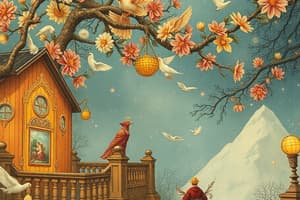Podcast
Questions and Answers
What is the key difference between similes and metaphors?
What is the key difference between similes and metaphors?
- Metaphors present comparisons as identical, while similes draw comparisons based on similarities.
- Metaphors compare unlike entities, while similes attribute human qualities to nonhuman entities.
- Similes compare unlike entities, while metaphors use 'like' or 'as' for comparison. (correct)
- Similes present comparisons as identical, while metaphors draw comparisons based on similarities.
In the sentence, 'Her words were a soothing balm to his wounded soul,' what literary device is being used?
In the sentence, 'Her words were a soothing balm to his wounded soul,' what literary device is being used?
- Metaphor (correct)
- Simile
- Personification
- Imagery
Which literary device attributes human qualities to nonhuman entities?
Which literary device attributes human qualities to nonhuman entities?
- Hyperbole
- Personification (correct)
- Simile
- Metaphor
Which of the following is an example of imagery?
Which of the following is an example of imagery?
Which literary device is used in the sentence, 'I've told you a million times'?
Which literary device is used in the sentence, 'I've told you a million times'?
What distinguishes personification from simile and metaphor?
What distinguishes personification from simile and metaphor?
Which literary device involves describing a person or object by comparing it to something else, without using 'like' or 'as'?
Which literary device involves describing a person or object by comparing it to something else, without using 'like' or 'as'?
In the context of Tennyson's poem 'The Lady of Shalott', what literary device is used to create vivid mental pictures for the reader?
In the context of Tennyson's poem 'The Lady of Shalott', what literary device is used to create vivid mental pictures for the reader?
Which literary device involves attributing human characteristics to non-human entities?
Which literary device involves attributing human characteristics to non-human entities?
What is the purpose of hyperbole in writing?
What is the purpose of hyperbole in writing?
Which device involves comparing two things using 'like' or 'as' to illustrate a similarity?
Which device involves comparing two things using 'like' or 'as' to illustrate a similarity?
How does personification help in storytelling?
How does personification help in storytelling?
Flashcards are hidden until you start studying
Study Notes
Literary Devices and Sound Devices: Enriching Language with Comparisons, Personifications, Imagery, and More
As you delve into the fascinating world of literature, enchanting phrases and intricate constructions capture your imagination, often stemming from literary devices that have been refined over centuries. In this exploration, we'll examine several such techniques—similes, metaphors, personification, imagery, and hyperbole—all of which heighten our appreciation for both spoken and written expression.
Similes
A simile is a comparison between two things using 'like' or 'as', drawing comparisons based on similarities rather than presenting them as identical. For instance, Shakespeare's infamous line, "Caesar's death made clefts out of men's hearts," compares Caesar's demise to a chasm, evoking emotional alarm with vivid clarity.
Metaphors
Metaphores compare unlike entities, emphasizing their inherent connections through analogy or allegory. Winston Churchill's iconic address during World War II offers a powerful example, stating, "We shall fight on the beaches ... We shall never surrender!" Here he likens Britain's resolve to an unyielding shoreline, conveying strength and resilience.
Personification
Personification attributes human qualities or characteristics to nonhuman entities, imbuing these elements with life, emotion, or agency. Consider how George Orwell lends anthropomorphic features to animals like pigs in his novel Animal Farm, making it easier for readers to connect with themes of power corruption and abuse within society.
Imagery
Imagery invokes sensory experiences by employing figurative language, allowing readers to form mental pictures of scenes, situations, or ideas. Tennyson's poem "The Lady of Shalott", for example, describes the lady captivated by the sights outside her tower window, painting exquisite visual images for the reader.
Hyperbole
Hyperbole involves deliberately and obviously exaggerating facts to create emphasis, humor, or dramatic effect, as in saying someone can run so fast they could catch lightning. This device is ubiquitous across cultures, used extensively in everyday speech and creative writing alike.
These literary devices help authors express complex concepts more effectively, revealing nuances that may otherwise remain hidden. By paying attention to their usage in various works, we can better appreciate the artistry behind each tale, honing our own communication skills in turn.
Studying That Suits You
Use AI to generate personalized quizzes and flashcards to suit your learning preferences.




